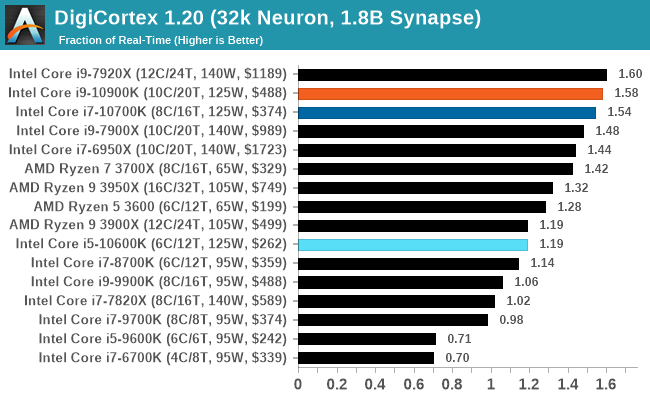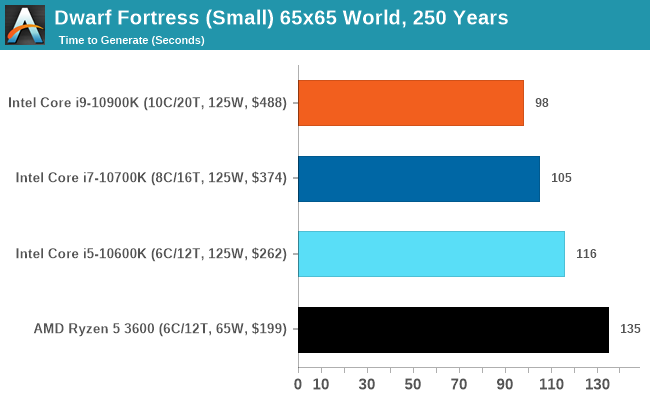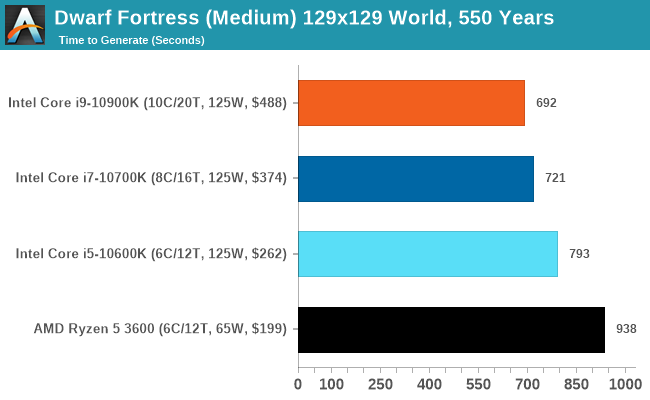The Intel Comet Lake Core i9-10900K, i7-10700K, i5-10600K CPU Review: Skylake We Go Again
by Dr. Ian Cutress on May 20, 2020 9:00 AM EST- Posted in
- CPUs
- Intel
- Skylake
- 14nm
- Z490
- 10th Gen Core
- Comet Lake
CPU Performance: Simulation Tests
A number of our benchmarks fall into the category of simulations, whereby we are either trying to emulate the real world or re-create systems with systems. In this set of tests, we have a variety including molecular modelling, non-x86 video game console emulation, a simulation of the equivalent of a slug brain with neurons and synapses firing, and finally a popular video game that simulates the growth of a fictional land including historical events and important characters within that world.
NAMD ApoA1
One frequent request over the years has been for some form of molecular dynamics simulation. Molecular dynamics forms the basis of a lot of computational biology and chemistry when modeling specific molecules, enabling researchers to find low energy configurations or potential active binding sites, especially when looking at larger proteins. We’re using the NAMD software here, or Nanoscale Molecular Dynamics, often cited for its parallel efficiency. Unfortunately the version we’re using is limited to 64 threads on Windows, but we can still use it to analyze our processors. We’re simulating the ApoA1 protein for 10 minutes, and reporting back the ‘nanoseconds per day’ that our processor can simulate. Molecular dynamics is so complex that yes, you can spend a day simply calculating a nanosecond of molecular movement.
This is one of our new tests, so we will be filling in more data as we start regression testing for older CPUs.

Dolphin 5.0: Console Emulation
One of the popular requested tests in our suite is to do with console emulation. Being able to pick up a game from an older system and run it as expected depends on the overhead of the emulator: it takes a significantly more powerful x86 system to be able to accurately emulate an older non-x86 console, especially if code for that console was made to abuse certain physical bugs in the hardware.
For our test, we use the popular Dolphin emulation software, and run a compute project through it to determine how close to a standard console system our processors can emulate. In this test, a Nintendo Wii would take around 1050 seconds.
The latest version of Dolphin can be downloaded from https://dolphin-emu.org/

DigiCortex 1.20: Sea Slug Brain Simulation
This benchmark was originally designed for simulation and visualization of neuron and synapse activity, as is commonly found in the brain. The software comes with a variety of benchmark modes, and we take the small benchmark which runs a 32k neuron / 1.8B synapse simulation, equivalent to a Sea Slug.
Example of a 2.1B neuron simulation
We report the results as the ability to simulate the data as a fraction of real-time, so anything above a ‘one’ is suitable for real-time work. Out of the two modes, a ‘non-firing’ mode which is DRAM heavy and a ‘firing’ mode which has CPU work, we choose the latter. Despite this, the benchmark is still affected by DRAM speed a fair amount.
DigiCortex can be downloaded from http://www.digicortex.net/

The additional bandwidth of the HEDT platforms put them higher up the chart here - Digicortex always ends up as an odd mix of bottlenecks mostly around memory, but it can be localized internal bandwidth limited as well.
Dwarf Fortress
Another long standing request for our benchmark suite has been Dwarf Fortress, a popular management/roguelike indie video game, first launched in 2006. Emulating the ASCII interfaces of old, this title is a rather complex beast, which can generate environments subject to millennia of rule, famous faces, peasants, and key historical figures and events. The further you get into the game, depending on the size of the world, the slower it becomes.
DFMark is a benchmark built by vorsgren on the Bay12Forums that gives two different modes built on DFHack: world generation and embark. These tests can be configured, but range anywhere from 3 minutes to several hours. I’ve barely scratched the surface here, but after analyzing the test, we ended up going for three different world generation sizes.
This is another of our new tests.














220 Comments
View All Comments
catavalon21 - Wednesday, May 20, 2020 - link
The ability to edit (or ^Z) would be most welcome, trust me.eastcoast_pete - Wednesday, May 20, 2020 - link
Isn't that Skylake running a bit dry by now? But, seriously, Intel really risks losing a lot of market share in future years by selling these "classics" at high prices, and that is if one can get one in the first place.Curious: how many commercial customers buy Intel desktops just because they have iGPUs, but want more CPU oomph than the 3200G has? Is that why Intel still dominates the OEM desktop market?
AnarchoPrimitiv - Wednesday, May 20, 2020 - link
Intel dominates the OEM market through intimidation and threats of retribution... They were literally convicted of bribing OEMs to NOT use AMD CPUs all throughout the 2000s in several courts around the world. The trials uncovered emails between Intel executives that stated, and I quote, "Dell is the best friend money can buy".... The proof is in the fact that currently, the Ryzen 4000 mobile CPUs are the best mobile chips offered right now, but Dell only puts them in the low end laptops. Why? Because Intel is probably giving huge financial incentives to bar AMD from premium designs to perpetuate the myth that AMD isn't a premium brandRetycint - Wednesday, May 20, 2020 - link
Do keep in mind that these are baseless speculations, based on something that happened 2 decades ago. Both Intel and AMD have changed since then (new engineering team, new management etc) and there has been no evidence of Intel providing incentives to cripple AMD systems. Go take your conspiracy elsewhere.And before you inevitably accuse me of being an Intel shill, this isn't about Intel or AMD, it's about facts to support your claim, of which there have been none
Irata - Wednesday, May 20, 2020 - link
Baseless speculation? Financial horsepower, MDF and meet the comp funds are current and no secret.Why do you think there are no Ryzen 4000 laptops with GPU above a 2060?
Spunjji - Tuesday, May 26, 2020 - link
Not entirely baseless, as they made two distinct claims. I've been a party to how Intel's "Marketing Development Funds" work - and work it does, at all levels from OEM to reseller to retailer. These days they don't explicitly punish anyone for not buying AMD - they simply tie rebates that will improve the profit margins on a product to specific quantities of those products being sold. It's "nobody's fault" if those quantities happen to make the sale of an AMD product by a given retailer or reseller distinctly unlikely.As for incentivizing bad *builds* of AMD systems, though, I'm not so sure. Intel clearly do a lot of work building reference platforms, and the economics of doing integration testing for a new vendor is not trivial. Honestly though, it's hard to tell how we *would* know if this were going on, because it would absolutely be made to look innocent - just like last time.
brantron - Wednesday, May 20, 2020 - link
"literally convicted of bribing"1) No. That's not what "literally" means.
2) No. No one was even *charged* with a crime, much less convicted.
3) No. It wasn't about bribery.
The reason Athlon 64s weren't ubiquitous way back when is the same reason the 4000 APUs aren't today - there aren't enough to go around.
If your post were to be rephrased without hyperbole, baseless accusations, and whataboutism unrelated to the topic of this article, it would read something like this:
"6 months after AMD's announcement of Renoir, the number of 4000 APUs sold for desktops is literally zero (see how that works?) because TSMC is still slammed."
WaWaThreeFIVbroS - Thursday, May 21, 2020 - link
Your ignorance is amusingIt is technically a bribery
https://www.extremetech.com/computing/184323-intel...
Spunjji - Tuesday, May 26, 2020 - link
First 3 points: accurate, if not entirely on-topic. Nobody was charged with a crime, but Intel sure were fined a lot for collusion.Which gets to the 4th point: again, accurate, but not entirely relevant. AMD were definitely not able to match Intel for manufacturing, which is why they couldn't have beaten Intel out of the market entirely, but that was barely related to why they weren't getting into Dell systems. See the aforementioned proven-and-fined-for collusion.
drothgery - Friday, May 22, 2020 - link
Or because premium designs take longer when the new chip isn't just another respin of the same thing, and AMD hadn't produced a viable high-end notebook chip in well over a decade so it made sense to wait and see if Ryzen 4000 was any good rather than designing in advance?